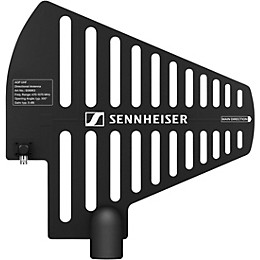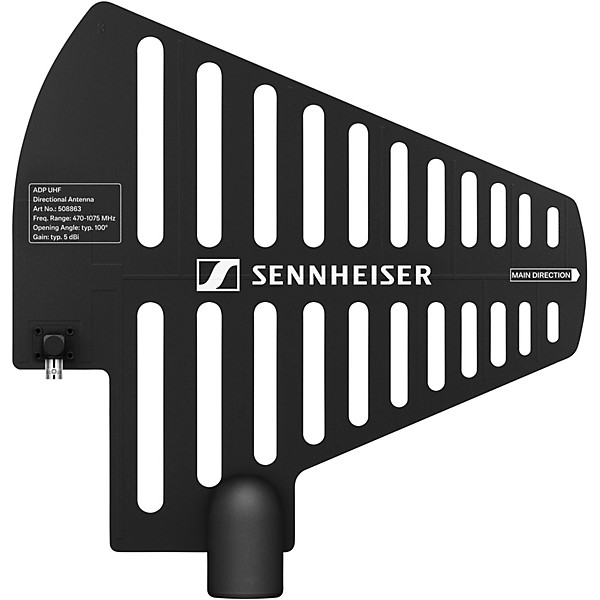- Popular Brands
Sennheiser ADP UHF Directional External Paddle Antenna, Passive UHF Range
Videos (1)
View All

Sennheiser - The Future of Audio

 Description
Description
Sennheiser's ADP UHF Directional external paddle antenna is a revolutionary solution for wireless systems, offering an effortless way to strengthen your signal exactly where you need it. Its passive design requires no additional power source, allowing for a quick and convenient setup. The ADP UHF operates within a wide UHF frequency range of 470MHz–1,075MHz to provide pristine reception and transmission. Its directional antenna focuses the signal to mitigate interference from other devices, ideal for live performances and presentations.
Passive Design Means No Hassle
The ADP UHF's passive design eliminates the need for an external power source, allowing you to simply connect it to your Sennheiser Evolution wireless system and aim the antenna where desired. With no batteries to charge or power cables to manage, setup and operation couldn't be simpler. The paddle-shaped antenna is thoughtfully designed to allow tilting and rotating to pinpoint and optimize your signal for the best possible reception.
Wide Frequency Range and Directional Pickup
With a UHF frequency range spanning 470MHz–1,075MHz, the ADP UHF provides exceptionally clear signal transmission and reception. Its directional antenna focuses the signal in the direction it's pointing to avoid interference from other devices operating on similar frequencies. The focused signal pickup is ideal for live events where clarity and reliability are paramount.
Backward Compatible With All Evolution Wireless Systems
The ADP UHF Directional external paddle antenna works with all Sennheiser Evolution wireless systems, both current and legacy models. Its universal compatibility provides an easy way to strengthen the signal of your existing wireless equipment, extending its functionality and usefulness. For pristine, uninterrupted signal transmission wherever you need it, the Sennheiser ADP UHF is an investment that will benefit your system for years to come.
Premium Quality You Can Count On
Sennheiser is renowned worldwide for manufacturing premium audio equipment, setting the standard for performance, build quality and reliability. The ADP UHF upholds this standard, providing an extremely well-constructed, durable solution for boosting your wireless signal with confidence. Experience the Sennheiser difference—rich, nuanced sound and gear that's built-to-last.

 Features
Features
- Digital wireless eliminates noise, interference and static bursts
- UHF transmission greatly enhances range, reliability and scalability
- Mobile App streamlines setup and operation and eliminates complicated menu
- Automated setup creates reliable connections with minimal time and effort
- Up to 2,240 selectable frequencies
- 56 MHz Bandwidth will allow for up to 90 channels
 Warranty
Warranty
Featured Articles
 Reviews
Reviews
Be the first to review the Product
 Q&A
Q&A
Have a question about this product? Our expert Gear Advisers have the answers.
submitted4 months ago
asked byMikki
fromCharlotte NC
Which Sennheiser wireless mic system is this antenna compatible with? I currently have the Sennheiser XSW 1-835.
The Sennheiser ADP UHF Directional External Paddle Antenna (Passive) is compatible with a wide range of Sennheiser wireless microphone systems that operate within the UHF frequency range (470–870 MHz). Compatible Sennheiser Wireless Systems (UHF Range): Evolution Wireless G3 / G4 Series (EW 100, EW 300, EW 500).. XS Wireless IEM and Digital systems (certain UHF models only — confirm connector compatibility).. Digital 6000 Series.. Digital 9000 Series.. EM 100/300/500 Receivers.. EK 100/300/500 Bodypack Receivers (when used in rackmount diversity systems).. A 2003-UHF (previous paddle antenna) can also be used interchangeably with ADP UHF in similar setups. Your system must operate in the UHF band. The receiver must support external antenna inputs via BNC connectors. Use of the antenna is especially helpful when: Rackmounting receivers and needing remote antenna placement. Improving reception range and minimizing dropouts. Directional coverage is preferred (ADP is directional).




